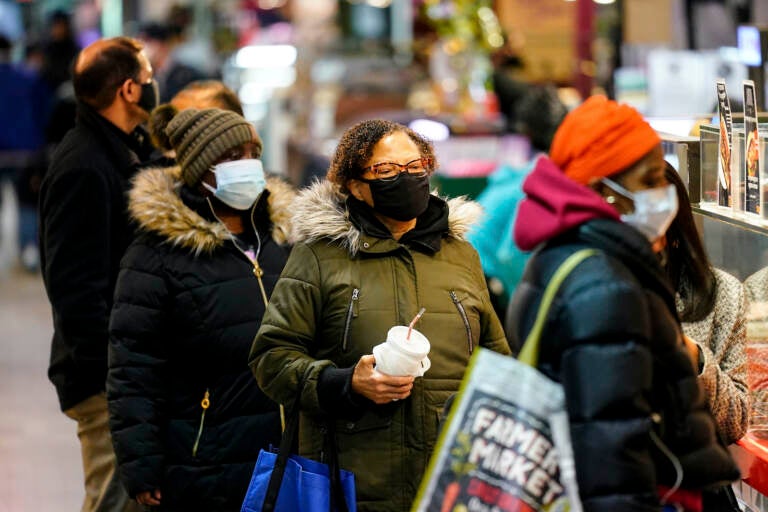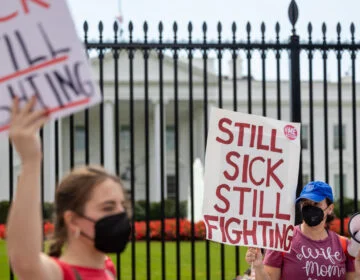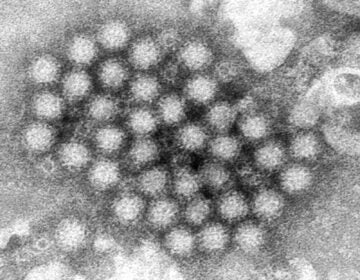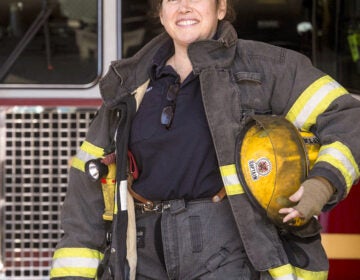What do the new CDC mask requirements mean for the Philadelphia region?
The CDC's shift reflects a substantial drop in COVID-19 cases nationwide.

Customers wearing face masks shop at the Reading Terminal Market in Philadelphia, Wednesday, Feb. 16, 2022. (AP Photo/Matt Rourke)
Today, the Centers for Disease Control and Prevention introduced a new system for evaluating when people should mask indoors, using more comprehensive metrics. The shift reflects a substantial drop in COVID-19 cases nationwide and recommends that for more than 70% of the U.S. population, masks are no longer needed in indoor spaces.
The new metrics still consider case counts, but also take into consideration new hospitalizations and hospital capacity, to determine when particular geographic locations should mask indoors. The previous system relied primarily on case counts, and resulted in 95% of the country falling under an indoor mask recommendation.
“We’re in a stronger place today as a nation with more tools to protect ourselves and our communities from COVID-19 like vaccination, boosters, broader access to testing, availability of high quality masks, accessibility to new treatments and improved ventilation,” said CDC director Dr Rochelle Walensky
She noted that more than 200 million people in the country are fully vaccinated, with 100 million boosted. Because of this, the overall risk of severe disease is now generally lower.
The new system aims to prevent severe illness and stop COVID-19 from infecting high risk population, she said
The new CDC system creates three risk levels for counties: Low, Medium and High. The Low level means that community transmission is relatively low and there is no strain on a community’s health care system. The low level does not require any masking. In communities designated “Medium”, there is some strain on the health care system and more individuals with severe disease. Residents in counties in that level are recommended to consult their doctors about wearing a mask, if they are at high risk. Communities will be considered “High” if there is significant transmission and strain on the health care system. In that case, masking is recommended indoors, including in school.
Vaccination rates were not factored into the risk tiers.
These standards apply to schools as well — masking is only recommended in schools that are in “High level” communities. The levels will not change masking requirements for travel, such as on airplanes.
Walensky said the metrics were designed for flexibility, in case another variant comes and precautions need to be ramped up again.
“We want to give people a break from things like mask wearing when levels are low, and have the ability to reach for them again in the future,” she said, adding that people should always wear a mask if they have symptoms for COVID-19 or have been exposed, said Walensky.
The levels of all counties will be updated regularly at cdc.gov.
Philadelphia and the surrounding counties currently fall into the “Medium” category. However, Philadelphia will continue to be guided by its own system, not the CDC’s recommendations, according to the health department. Philadelphia’s tiered system specifying benchmarks at which restrictions would be lifted is similar to the CDC’s, and was introduced earlier this month.
Currently, Philadelphia is in the “Mask Precautions” phase: that means lifting the vaccine mandates for public indoor spaces, but keeping the mask requirement.
The city will continue to use the thresholds it developed based on positivity rate, case numbers, hospitalizations and the rate of increase to trigger Philadelphia into its final “All Clear” phase. In that phase, all restrictions are lifted but masks remain required in schools, health care institutions, congregate settings and on public transportation – notably still more restrictive than CDC guidance.
The city must meet 3 of the thresholds for the category to move into the final phase. Currently it meets 2 of the benchmarks: the positivity rate is 1.4% (it needs to be below 2%) and cases have not risen by more than 50% in the last 10 days. Hospitalizations are still too high as are the average daily case counts to lift the remaining requirements.
In the rest of Pennsylvania and New Jersey, mask mandates in indoor public spaces had already been lifted, including in schools. Delaware was planning to drop its school mask mandate on April 1. The state level decisions are in line with the new CDC system for New Jersey, all of which is considered the “low” or “medium”, where masking is not recommended. All of Delaware is considered “Medium.” Some counties in central and Northeast Pennsylvania are still considered high risk, according to the new metrics, but most are “Low” or “Medium.”
WHYY is your source for fact-based, in-depth journalism and information. As a nonprofit organization, we rely on financial support from readers like you. Please give today.




![CoronavirusPandemic_1024x512[1]](https://whyy.org/wp-content/uploads/2020/03/CoronavirusPandemic_1024x5121-300x150.jpg)



